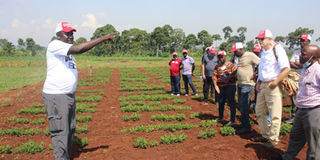Scientist, farmers embark on groundnuts value addition

David Kalule Okello explains to scientists how new groundnut varieties will yield more. Photo / Shabibah Nakirigya
What you need to know:
- According to Michael Ugen, director of research, at National Semi-Arid Resources Research Institute (NaSARRI), hundreds of farmers in eastern Uganda can increase their income if they add value to their groundnuts.
Peanut Innovation Laboratory Project, a project that was started four years ago and has been involved in crop research business is set to launch a platform to help equip farmers with skills in value addition.
According to Michael Ugen, director of research, at National Semi-Arid Resources Research Institute (NaSARRI), hundreds of farmers in eastern Uganda can increase their income if they add value to their groundnuts.
“The impact therefore will be to create a more sustainable value chain which will enable farmers have steady and consistent income as they focus on the effects of climate change,” says Ugen. “This project will help us get to the next level of value addition, we do not want to produce groundnuts for the sake of producing but adding value to it so that those who are involved earn more,” he says. According to Mary Grace Obangamara of Ivory Organic Limited, farmers can triple income by joining organised marketing systems that play an important role in supporting small agricultural producers and marginalised groups such as young people and women.
“We have started guiding farmers on how they can handle the groundnuts especially after harvesting with regards on how to keep them safe for the people who consume them. After getting the groundnuts it is our responsibility to come up with good products, we create a product which is healthy and has a good nutritional benefit of it,” she says.
Value addition process
Apart from just eating them raw or cooked, groundnuts can be used to produce oil, paste, flour or sauce used in cakes and cookies obtained by grinding nuts, and peanut butter.
Value addition ensures processed products fetch good prices in the market and the shelf life is increased.
The process of making peanut butter starts with the buying and collection of unshelled peanut from farmers.
It is important to get the groundnuts whole and unshelled to avoid seed contamination. The dry unshelled peanuts are then sorted to remove those that are spoiled.
The peanuts are then shelled using a peanut sheller machine which is followed by more sorting out to remove rotten seeds.
The seeds are then roasted in a roasting machine then cooled to remove the seed coat. Some of the seed coat is however left intact as it is highly nutritious. Big peanuts roast faster than smaller peanuts and give better quality peanut butter.

More sorting out is done to ensure a high-quality final product.
The peanut seeds are ground in a stainless machine and moderately cooled for 15 to 20 minutes, before packaging in well-labelled packets and containers in readiness for the market. Through this process, the shelf life of the groundnuts is then increased by up to 12 months or more with no preservatives added.
The peanut oil acts as its preservative which separates and settles at the top a day after packaging.
Peanut butter can be eaten as it is - in its pasty form, spread on bread, apples, biscuits and other foods for a good snack, put into smoothies to add flavour or used for cooking foods such as vegetables and soups.
Process
The process of making peanut butter starts with the buying and collection of unshelled peanut from farmers. It is important to get the groundnuts whole and unshelled to avoid seed contamination.
The dry unshelled peanuts are then sorted to remove those that are spoiled.
The peanuts are then shelled using a peanut sheller machine which is followed by more sorting out to remove rotten seeds.




